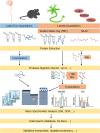Proteomics Approaches for Biomarker and Drug Target Discovery in ALS and FTD
- PMID: 31244593
- PMCID: PMC6579929
- DOI: 10.3389/fnins.2019.00548
Proteomics Approaches for Biomarker and Drug Target Discovery in ALS and FTD
Abstract
Neurodegenerative disorders such as amyotrophic lateral sclerosis (ALS) and frontotemporal dementia (FTD) are increasing in prevalence but lack targeted therapeutics. Although the pathological mechanisms behind these diseases remain unclear, both ALS and FTD are characterized pathologically by aberrant protein aggregation and inclusion formation within neurons, which correlates with neurodegeneration. Notably, aggregation of several key proteins, including TAR DNA binding protein of 43 kDa (TDP-43), superoxide dismutase 1 (SOD1), and tau, have been implicated in these diseases. Proteomics methods are being increasingly applied to better understand disease-related mechanisms and to identify biomarkers of disease, using model systems as well as human samples. Proteomics-based approaches offer unbiased, high-throughput, and quantitative results with numerous applications for investigating proteins of interest. Here, we review recent advances in the understanding of ALS and FTD pathophysiology obtained using proteomics approaches, and we assess technical and experimental limitations. We compare findings from various mass spectrometry (MS) approaches including quantitative proteomics methods such as stable isotope labeling by amino acids in cell culture (SILAC) and tandem mass tagging (TMT) to approaches such as label-free quantitation (LFQ) and sequential windowed acquisition of all theoretical fragment ion mass spectra (SWATH-MS) in studies of ALS and FTD. Similarly, we describe disease-related protein-protein interaction (PPI) studies using approaches including immunoprecipitation mass spectrometry (IP-MS) and proximity-dependent biotin identification (BioID) and discuss future application of new techniques including proximity-dependent ascorbic acid peroxidase labeling (APEX), and biotinylation by antibody recognition (BAR). Furthermore, we explore the use of MS to detect post-translational modifications (PTMs), such as ubiquitination and phosphorylation, of disease-relevant proteins in ALS and FTD. We also discuss upstream technologies that enable enrichment of proteins of interest, highlighting the contributions of new techniques to isolate disease-relevant protein inclusions including flow cytometric analysis of inclusions and trafficking (FloIT). These recently developed approaches, as well as related advances yet to be applied to studies of these neurodegenerative diseases, offer numerous opportunities for discovery of potential therapeutic targets and biomarkers for ALS and FTD.
Keywords: amyotrophic lateral sclerosis; frontotemporal dementia; mass spectrometry; protein aggregation; proteomics.
Figures

Similar articles
-
Molecular basis of ALS and FTD: implications for translational studies.Arh Hig Rada Toksikol. 2015 Dec;66(4):285-90. doi: 10.1515/aiht-2015-66-2679. Arh Hig Rada Toksikol. 2015. PMID: 26751860 Review.
-
Selective Genetic Overlap Between Amyotrophic Lateral Sclerosis and Diseases of the Frontotemporal Dementia Spectrum.JAMA Neurol. 2018 Jul 1;75(7):860-875. doi: 10.1001/jamaneurol.2018.0372. JAMA Neurol. 2018. PMID: 29630712 Free PMC article.
-
Emerging perspectives of synaptic biomarkers in ALS and FTD.Front Mol Neurosci. 2024 Jan 5;16:1279999. doi: 10.3389/fnmol.2023.1279999. eCollection 2023. Front Mol Neurosci. 2024. PMID: 38249293 Free PMC article. Review.
-
The neuropathology of FTD associated With ALS.Alzheimer Dis Assoc Disord. 2007 Oct-Dec;21(4):S44-9. doi: 10.1097/WAD.0b013e31815c3486. Alzheimer Dis Assoc Disord. 2007. PMID: 18090423 Review.
-
Altered serum protein levels in frontotemporal dementia and amyotrophic lateral sclerosis indicate calcium and immunity dysregulation.Sci Rep. 2020 Aug 13;10(1):13741. doi: 10.1038/s41598-020-70687-7. Sci Rep. 2020. PMID: 32792518 Free PMC article.
Cited by
-
The Need for Biomarkers in the ALS-FTD Spectrum: A Clinical Point of View on the Role of Proteomics.Proteomes. 2023 Jan 9;11(1):1. doi: 10.3390/proteomes11010001. Proteomes. 2023. PMID: 36648959 Free PMC article. Review.
-
miR-92a-3p and miR-320a are Upregulated in Plasma Neuron-Derived Extracellular Vesicles of Patients with Frontotemporal Dementia.Mol Neurobiol. 2025 Feb;62(2):2573-2586. doi: 10.1007/s12035-024-04386-z. Epub 2024 Aug 14. Mol Neurobiol. 2025. PMID: 39138758 Free PMC article.
-
The p97 Inhibitor UPCDC-30245 Blocks Endo-Lysosomal Degradation.Pharmaceuticals (Basel). 2022 Feb 7;15(2):204. doi: 10.3390/ph15020204. Pharmaceuticals (Basel). 2022. PMID: 35215314 Free PMC article.
-
ALS plasma reduces the viability of NSC34 cells via altering mRNA expression of VEGF: A short report.Heliyon. 2023 Jul 14;9(7):e18287. doi: 10.1016/j.heliyon.2023.e18287. eCollection 2023 Jul. Heliyon. 2023. PMID: 37519724 Free PMC article.
-
Advances in High Throughput Proteomics Profiling in Establishing Potential Biomarkers for Gastrointestinal Cancer.Cells. 2022 Mar 11;11(6):973. doi: 10.3390/cells11060973. Cells. 2022. PMID: 35326424 Free PMC article. Review.
References
-
- Acquadro E., Caron I., Tortarolo M., Bucci E. M., Bendotti C., Corpillo D. (2014). Human SOD1-G93A specific distribution evidenced in murine brain of a transgenic model for amyotrophic lateral sclerosis by MALDI imaging mass spectrometry. J. Proteome Res. 13 1800–1809. 10.1021/pr400942n - DOI - PubMed
-
- Arai T., Hasegawa M., Akiyama H., Ikeda K., Nonaka T., Mori H., et al. (2006). TDP-43 is a component of ubiquitin-positive tau-negative inclusions in frontotemporal lobar degeneration and amyotrophic lateral sclerosis. Biochem. Biophys. Res. Commun. 351 602–611. - PubMed
Publication types
LinkOut - more resources
Full Text Sources
Miscellaneous

